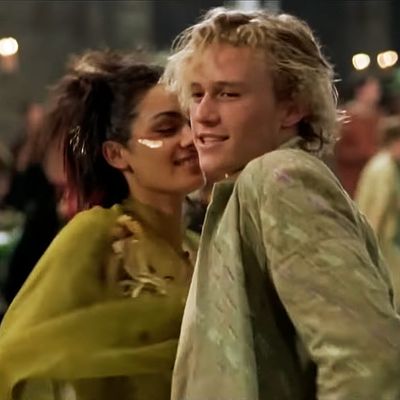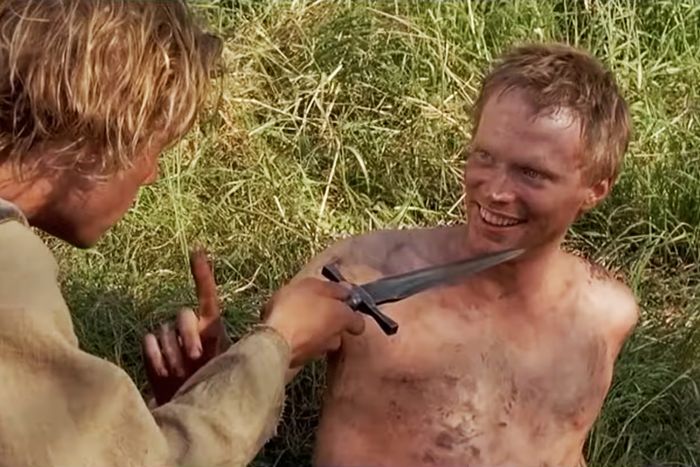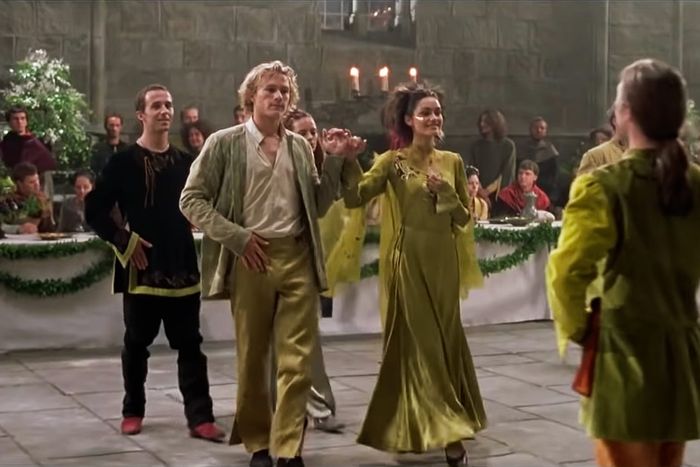
Once upon a time in a treacherous land called LAX, two men met at the flying-saucer-shaped restaurant that used to hover over the tarmac. Designed by Disney Imagineers and decked out with lava lamps and fiber-optic lighting, the futuristic hot spot called Encounter was once described as “the kinda place George Jetson, James Bond, and Barbarella could drink together.”
Reportedly frequented by everyone from Shaq to the Austin Powers cast during its late-’90s heyday, on this occasion, Encounter played host to Heath Ledger. It was 1999, and the actor was on his way home to Australia on a break from filming The Patriot in South Carolina. Executives at Sony had encouraged the airport-adjacent meeting with Brian Helgeland, who had won a screenwriting Oscar for 1997’s L.A. Confidential and penned a new genre-defying film he would also direct for the studio’s Columbia imprint. Perhaps, the studio thought, Helgeland’s A Knight’s Tale could serve as a breakout lead role for Ledger after his beloved but secondary billings in 10 Things I Hate About You and The Patriot.
Ledger arrived prepared. Carrying just a single tube that housed his didgeridoo off the plane, the 20-year-old had already devoured Helgeland’s script and had feedback ready. “He said, ‘I’m reading it and it’s dramatic, and I’m reading some more and it’s comedy, and I’m reading some more and I’m riding a horse and I’m singing and I’m sword-fighting and jousting,’” Helgeland recalls. “Then he said, ‘And I get to page 50 or whatever, and now I’m dancing.’ He goes, ‘You had me at singing, but now I’m dancing? I’m in.’”
Helgeland says he originally assumed, probably correctly, that no one would understand his pitch for a movie about a lowly medieval squire named William Thatcher who pretends to be a knight named Sir Ulrich von Liechtenstein in order to compete in jousting tournaments for money and a noblewoman’s heart, all while 1970s rock thumps in the background. So Helgeland wrote the full script up front, complete with “needle drops,” during which he envisioned utilizing songs by Queen and Thin Lizzy to guide the story. He argued that using a traditional orchestral score with violins was just as anachronistic as electric guitars, since violins hadn’t been invented in the 1300s yet either. Plus, stadium sports like jousting required stadium music. And whether set in the 1370s or the 1970s, he says, “the ’70s are always the ’70s.”
“I wasn’t throwing it in there for a gimmick,” Helgeland adds. “Some people might think it’s a gimmick, but in my head, it was never a gimmick.”
Unlike Moulin Rouge!, which also premiered in May 2001, A Knight’s Tale isn’t an all-out song-and-dance extravaganza. Apart from a stadium of extras chanting “We Will Rock You,” the actors don’t sing along to the classic rock songs that make up the film’s soundtrack. Ledger gets a moment of a cappella on horseback and that single, perfect scene filled with the dancing that so excited him: the jubilant, sensual explosion of Bowie meets ballroom.
The scene begins with William — who everyone else thinks is Sir Ulrich — nervously entering a banquet hall after learning the basics of dancing the night before in an attempt to woo Lady Jocelyn (played by Shannyn Sossamon). But the villainous Count Adhemar (Rufus Sewell) sets William up for failure by demanding he show the crowd a dance from his fake homeland of Gelderland. William bumbles through a few opening steps before Jocelyn rescues him with her dancing prowess. Soon, everyone is diligently copying a series of pretty but staid medieval steps.
And then David Bowie’s “Golden Years” kicks in and magic unfolds.
Ledger goes full Travolta, mouthing the “angel” lyric (his own idea to draw in the movie audience and “break the wall,” Helgeland says) as he leaps and twists through the air. Sossamon waves her billowing bell sleeves and shimmies across the disco floor. Shooting in Prague in the summer of 2000, the film crew couldn’t locally source dripless candles for the chandeliers that hung over the dance floor, so the actors were also skillfully dodging hot wax as they performed their moves.
In the script, Helgeland had envisioned KC and the Sunshine Band’s “Get Down Tonight” for the scene, and, initially, the cast rehearsed choreography to that song instead. But Ledger had another idea. “When Heath wanted to sell you on something, you could tell in a second,” Helgeland says, laughing. “He would assume this kind of boyishness to him; he’d become nine years old, like out of a Dickens story, like the Artful Dodger.”
During rehearsals, Ledger asked Helgeland if they could change the song to “Golden Years.” Helgeland was skeptical. They’d been practicing “Get Down Tonight” in the former hockey rink that would serve as their medieval banquet hall, and it was working really well. And wouldn’t choreographer Stuart Hopps have to create entirely new steps if they switched it up now?
“Heath got this big grin on his face. He goes, ‘It’s the same tempo. It’s going to work,’” Helgeland says. “He said, ‘Don’t come to rehearsal today. Let us get it right and then come down. We’ll do both of them and you decide.’”
Ledger had successfully pulled a similar move on the 10 Things set, convincing filmmakers to change his character’s bleacher serenade from “I Touch Myself” to the more romantic “Can’t Take My Eyes Off You.” And this time, he was ready with a final plea to drive home his sale, arguing the lyrics of “Golden Years” spoke directly to William’s onscreen journey.
“He was like, ‘It’s so inescapable that it should be ‘Golden Years’ that there’s no way you can disagree with me.’ He just laid it all out like a legal case.”
Hopps, the choreographer who also appears in the scene as the dance master, says he happily co-signed the change.
“At the time, I thought that the Bowie choice was a good one,” Hopps writes in an email to Vulture, “and although the dance patterns remained much the same, the choice of music meant I could give the dance routine a more modern feel and get the actors to let go more and swing more.”
For Sossamon, the dancing scene, like most of the film, is a blur. “I have not seen the movie since [it came out]. It hurts too much for so many reasons,” she says, Googling images from A Knight’s Tale to jog her memory mid-call. “Even separate from Heath, it’s like, You’re just so young. All I see is [my] mistakes, and it’s too hard.”
Before casting Ledger, Helgeland considered several other actors for the role of William, including Paul Walker. But he wasn’t convinced an American could pull off the requisite British accent. “Even though Heath’s not doing a super-strict accent or anything, between being Australian and going for the language [of the era], he does sound like he belongs there,” Helgeland says.
For the role of Jocelyn, Helgeland met with Kate Hudson but ultimately cast Sossamon, who was then a DJ, dancer, and model discovered by casting director Francine Maisler at Gwyneth Paltrow’s birthday party.
“Brian wanted the character to have a [certain] quality and then it was about the chemistry with Heath, and that was it. They thought everything else I would be able to just figure out,” Sossamon says amusedly. “I didn’t know who Heath was. I hadn’t seen that movie [10 Things I Hate About You], and I wasn’t following Hollywood. I only knew who the really famous people were.”
At the time, the studio felt Mark Addy was the most well-known face in the ensemble, following the success of The Full Monty. And though Helgeland says Sony pushed for Hugh Grant to take on the role of Geoffrey Chaucer, a part that required considerable nudity, Helgeland had written it with his friend Paul Bettany in mind and gave him his first major movie role instead.
“Nothing against Hugh Grant,” the director says, “but I don’t see him fitting in with the boys.”
To make the “Golden Years” scene work, composer Carter Burwell had the postproduction challenge of creating a traditional, 1300s-esque musical score that could gradually and seamlessly transition into Bowie.
“It seemed to me that rather than just having my piece of music, say, fade in and out with ‘Golden Years,’ which a DJ could do, it would be a lot more interesting if you could bring in the occasional sound,” Burwell says. “‘Golden Years,’ like a lot of Bowie songs, is built from a few iconic sounds like the harmonica or the castanet. And if I could just grab a few of those things and bring them into my music, you would hear it, but it wouldn’t obviously be ‘Golden Years.’”
But asking an artist to lend their song for a remix is a much more tedious request than simply licensing the track to play as is in a movie. Plus, they’d need access to the original 24-track tapes in order to separate the individual sounds and fulfill Burwell’s vision. Bowie agreed on one condition: He wanted the song’s original producer, Tony Visconti, to handle the tapes and be present for the process.
Burwell happily complied. And when it came time to work on the track at a studio in New York, the singer himself showed up as well. “I guess Mr. Bowie was intrigued by the whole idea,” Burwell says. “The process was like a walk down memory lane with Tony Visconti and David Bowie. They just sat there shooting the breeze about how they recorded the song. They’re talking about, ‘Do you remember when we recorded that? And how we ran out of tracks to do this?’ It was really a big highlight for me.”
In Prague, a continent away from meddling studio suits, Helgeland & Co. felt free to create the exact kind of ambitious, unabashedly fun film they wanted. “There was no one breathing down our necks, saying, ‘What’s it going to look like?’” costume designer Caroline Harris says. “All those crazy little nitpicking things that can really take the life out of something.”
To bridge modern and medieval fashions, she took inspiration from the Rolling Stones’ flowy, cleavage-baring tops and looked to cowboys for the idea that these 14th-century European men would wear some form of chaps. When, in the “Golden Years” scene, William is meant to be dressed in a DIY outfit made out of a tent, Harris actually sourced his jacket and pants from a pile of embroidered throws.
“We kind of ran at this with pounding hearts and screaming enthusiasm, all of us,” Harris says. “I think it was something like ten weeks from day one to shooting — and that’s making all the armor, too. Everything was made from scratch.”
Between takes, the music came in the form of Bettany, who serenaded everyone with his guitar and penned impromptu tunes about the camera crew, Helgeland remembers. And on off days, the relatively unknown cast was free to traipse around Prague, haunting local pubs in search of cheap beer.
“There was so much beer-drinking,” Sossamon says. “I remember that, and a lot of laughing and hanging out and then trying to show up for work and have fun at work, too.”
When it was time for the film’s L.A. premiere, months later, everyone desperately attempted to replicate the carefree vibe of that Prague summer.
“We were just trying to drink beer as fast as we could. Everyone was just trying to get drunk,” Helgeland says. “Those things are so awkward, and, really, you want to re-create a bar in Prague rather than [be at] a premiere on Sunset or Hollywood Boulevard.”
Echoes Sossamon, “We were a funny team in that way. We just all felt really comfortable going there. I’m a little bit embarrassed now. It was like, Okay, we’re not in Prague anymore, and we’ve taken this too far. But it was definitely a vibe.”
When A Knight’s Tale hit theaters on May 11, 2001, most critics didn’t know what to make of it. Was it a historical romance, a buddy comedy, a sports story, a musical? Reviews were middling. Newsweek lamented, “There are worse crimes than crowd pleasing, but at least do it with some finesse,” while USA Today sniffed that it “may please aficionados of oldies stations and Xtreme sports but few others.” Audiences, however, loved it. A Knight’s Tale grossed more than $117 million at the global box office against its $65 million budget and skyrocketed Ledger — who hated the fact that his face was the only one on the poster — to new heights.
“I’m not like an avant-garde filmmaker or something. I just try to make the movie that I want to go see, which I did,” Helgeland says. “I didn’t mind the bad reviews, but the mediocre ones, when they said things like ‘It’s a guilty pleasure’ or implied we made it without knowing what we were making, like, ‘The music is good in spite of the fact that they put it in here’ — it’s like, We didn’t trip over it and pick it up and stick it in the movie!”
For young viewers who were more accustomed to Casey Kasem’s American Top 40 offerings of then-hits like “Thong Song” and “Kryptonite” (classics in their own right), A Knight’s Tale and its soundtrack opened up a thrilling new world of classic rock to explore. The “Golden Years” scene was nominated for a 2002 MTV Movie Award for Best Musical Sequence, losing to the “Elephant Love Medley” from Moulin Rouge!, which also sampled Bowie and a host of other legends.
And as the years passed, A Knight’s Tale maintained its cherished place in the hearts of viewers. Burwell says he rarely gets fan mail for his compositions outside of crafting “Bella’s Lullaby” for Twilight but that A Knight’s Tale touched a similar nerve. Online, fans routinely cite A Knight’s Tale on their personal lists of “perfect” movies and “favorite sports films of all time.” As one aptly tweeted, “It’s the film I could most honestly describe as ‘a bop.’”
There was talk of doing a Knight’s Tale sequel in the early 2000s, which Helgeland says would have seen Jocelyn get kidnapped by Count Adhemar and taken to Constantinople, forcing William and the gang to take a journey by boat to rescue her. Set in the 1380s, that film, naturally, would have had an ’80s soundtrack. It never came to fruition, and after Ledger’s tragic death at age 28 in 2008, the idea was scrapped.
More recently, Helgeland says, a London theater company bought the stage rights to adapt A Knight’s Tale into a musical, and, separately, “Alan Tudyk and Paul Bettany worked up a [movie] pitch not too long ago that William’s daughter wanted to joust, so the old gang gets together and trains her up. Of course, she can’t take her helmet off because she’s a woman. The music would be in the late ’90s. We can still do that.”
Sossamon says she wouldn’t need to be asked twice. “Heck yes. I would be so down,” she says exuberantly. “I would see it as an opportunity to really make Jocelyn whole and totally right rather than just flying by the seat of my pants.”
For now, A Knight’s Tale remains cemented in nostalgia and a point of pride for those involved. “It’s all fond memories,” Sossamon concedes. “I met two of my dearest friends. Brian’s a great friend to this day, and Heath obviously is in spirit.”
Helgeland says Ledger used to tell him that A Knight’s Tale felt like “a photo album of how much fun he had making it. Every scene, he could remember what funny stuff happened that day and whether we did this scene hung-over.” The actor and director remained close in the years that followed and worked together on the 2003 horror film The Order.
Sequels aside, the pair was eager to collaborate again, and Helgeland offered Ledger a lead role as the younger brother in a film he wrote about two siblings called Finest Kind. “He said that he really wanted to play the older brother, who was 35. I said, ‘But you’re not old enough to play the older brother,’” Helgeland says, his voice catching with emotion. “And then he got that look like when he was selling ‘Golden Years,’ like a little kid you can’t resist. He said, ‘Well, then wait for me.’ I said ‘All right’ and then, obviously, he never got there.”
(In 2018, it was announced that Jake Gyllenhaal and Ansel Elgort would star as the Finest Kind brothers, though production has yet to move forward.)
Ultimately, what resonates for Helgeland, beyond the devastating loss of his friend and colleague, is the impact Ledger left on all who crossed his path.
“I never saw someone like that. Everyone just fell in love with him — guys, girls, everybody,” Helgeland says. “Just everyone loved him, and he loved you back.”



